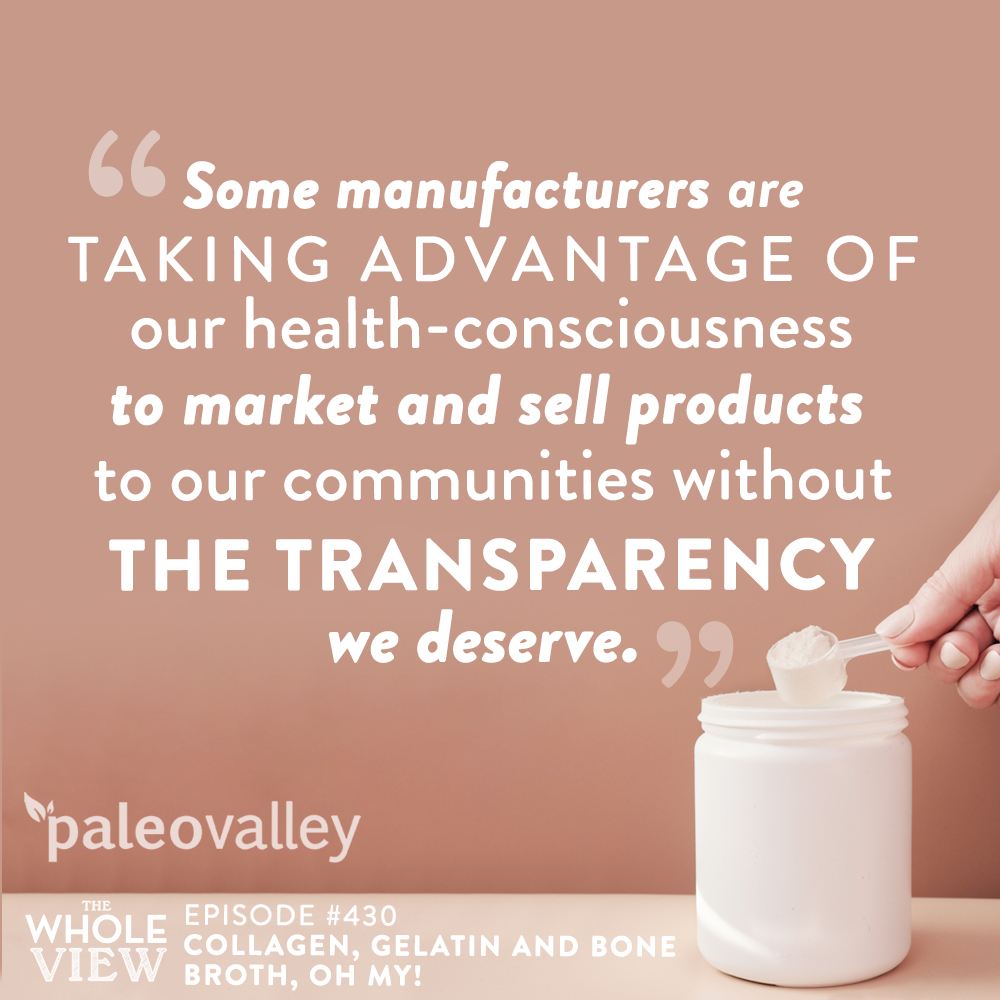Collagen, gelatin, and bone broth update: Here are the collagen brands Stacy currently uses. Be aware that the most popular brand includes heavy metals and more discussed here.
- This is the one I use and recommend daily, with the most transparency and highest testing and safety standards.
- This one also disclosed its practices and uses the ideal process, tho no safety testing was disclosed.

Welcome to episode 430 of The Whole View! This week, Stacy and Sarah dive into the topic of collagen, gelatin and bone broth. They take a look at what collagen is and how it works. They explore the pros and cons of food and supplement forms collagen, gelatin, and bone broth. Lastly, they give viewers some great tips for what to look out for when navigating the market for themselves!
If you enjoy the show, please review it on iTunes!
The Whole View, Episode 430: Collagen, Gelatin and Bone Broth, Oh My!
Welcome back to episode 430 of the Whole View. (0:27)
Stacy starts off the show by apologizing in advance for just how long this show is because there is a lot of science around collagen, gelatin, and bone broth.
She assures listeners she and Sarah will break down all the information simply. They will also provide recommendations for the audience.
Stacy shares that sometimes we have to admit that sometimes we get things wrong in the past.
That is why she and Sarah to do all the research they can, so the information and recommendations going forward can set us all up for success.
Stacy reminisces about the paleo community once knew her as the “Bone Broth Lady.”
She tells the audience how much better collagen, gelatin, and bone broth has made her body feel.
Stacy also points out that it is an ongoing process. And how changes in the formula of a brand she uses often have her revisiting information about collagen.
Sarah shares that she also uses this brand. After the ingredient change, she tells the audience how flooded her inbox was with questions because many additives are wheat and soy-derived.
She reached out to the company about where this one particular ingredient came from. But she was unable to get a response.
Sarah explains that many of Stacy’s followers didn’t even realize the formula changed due to the same packaging.
She shares people have been reaching out to them about starting to react.
Her mother has celiac’s disease and began reporting joint pain, which stopped as soon she stopped using the product. .
The Collagen Market Boom
After the formula change, Sarah started digging into the research around collagen, gelatin, and bone broth to try and find an alternative. It turned into a “down the rabbit hole” experience for her.
She’s written about this research on many occasions for listeners who would like even more information.
Sarah tells listeners how, in the last few years, the collagen industry has boomed. (6:05)
With this boom, technology has also changed. This means that the variety of available collagen, gelatin, and bone broth products and supplements has also changed.
There’s gelatin, collagen protein, collagen peptides, hydrolyzed collagen, collagen hydrolysate, marine collagen, multi-collagen, bone broth collagen, and bone broth protein.
Each are packaged and sold in an ever-increasing collection of products, from protein powders to protein bars, cookies, beverages, coffee creamers, capsules, gummies, and more.
While American consumers spent about $50 million on collagen supplements in 2014, upwards of $293 million is expected to be spent on collagen supplements in 2020.
According to the market research firm Nutrition Business Journal, the global market’s projected reach is $7.5 billion by 2027.
One of the results of this boom is the range of manufacturing processes.
As the market saturates with collagen-based products, manufacturers vie for your dollar and loyalty with compelling claims.
It’s important to be an informed consumer. Not all collagen supplements are created equal.
Sarah explains she really wants to get into the science behind the manufacturing processes are. And the myths surrounding the digestibility of these products.
Paleovalley
Before Stacy and Sarah get into all the science, they take a moment to announce how excited they are to have this episode sponsored by Paleovalley.
Paleovalley makes a bone broth protein that is 100% grass-fed beef bone that is slow-simmered for a long time, just like Sarah makes at home. It’s then gently dehydrated and powered.
Sarah expresses how it’s the cleanest product she’s come across on the market so far.
Paleovalley has so many great products to offer. Listeners can automatically receive 15% of their purchases by following this link or using the code “thewholeview15” at checkout.
Stacy takes a minute to add the protein powder from Paleovalley is an excellent add-in to many soups and stews for added nutrients.
She also asks listeners to re-think how they supplement.
Stacy explains how there are so many different ways you can add collagen, gelatin, and bone broth into your life.
She uses the example that she only likes coffee nowadays with collagen added because she’s been drinking that way for so long.
Stacy shares that when she first looked into her research on the subject years ago, she looked at things like Amino Acid profiles.
She mentions that it never occurred to her how or why collagen would be something that could dissolve in cold water.
Stacy encourages listeners that in the event they get lost in this show’s information, remember that ultimately the goal is not to remember everything.
Stacy mentions that on the Paleovalley website, listeners will not find Collagen Peptides. And they will explain a little more on that later in the show.
What is Collagen?
Collagen, gelatin, and bone broth all come from an animal’s bone, which is a hard thing. (11:00)
Taking a powder made from bone and expecting to dissolve it in a cold beverage doesn’t make a lot of sense.
Sarah laughs that this is a topic better suited to have visual aids and assures listeners that she will do the best she can without them.
Collagen is the most abundant protein in our bodies. It accounts for approximately 30% of all our proteins.
Our dominant structural protein is the main building block of connective and interstitial tissues, bone, cartilage, ligaments, tendons, and skin.
It’s also abundant in muscles, blood vessels, corneas, and teeth.
In fact, there is a role for collagen in just about every cell of the human body, which makes it a phenomenally important protein.
The word collagen comes from the Greek “kólla,” which means glue!
Although collagen functionally acts as a glue—holding cells, tissues, and organs together—and a structural scaffold.
There are 29 currently-identified genetically-distinct types of collagen, encoded by at least 46 genes. Their quaternary structures and architecture categorize them.
The Structure of Collagen
A triple helix tertiary structure is the base for all collagen.
Three polypeptide chains that tightly twist around each other form this helix.
A polypeptide chain is a long string of amino acids, called α-chains, each predominantly composed of a repeating sequence of three amino acids.
They vary in length from about 600 amino acids to over 3000 amino acids long)
About a third of the amino acids in collagen is glycine. Glycine is always the first amino acid in the repeating sequence of three amino acids that forms the α-chains.
The other two proteins making up the repeating sequence are commonly Proline and hydroxyproline.
The collagen triple helix (also called procollagen) undergoes post-translational modifications to become a basic collagen molecule (also called tropocollagen).
Collagen molecules spontaneously self-assemble into a diversity of larger structures. This is influenced by:
- the constituent α-chains (the combination of different α-chains determines which of the 29 types of collagen it is)
- other matrix molecules (such as elastin, keratin, and proteoglycans) and adjacent cellular elements.
Many different types of collagen can form, depending on how these ropes twist together.
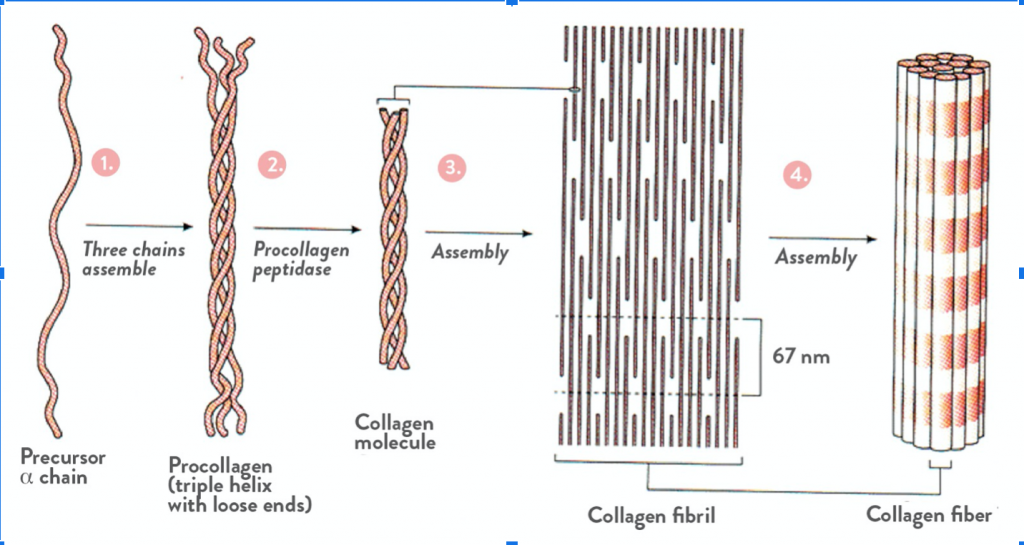
Type 1 Collagen
Type 1 Collagen is the most common and abundant type. (16:28)
Sarah tells the audience that it was the first type of collagen discovered, partly because it accounts for roughly 90% of the collagen in our bodies.
It is categorized as fibrillar collagen because the collagen molecules align to form fibrils, then self-assemble to form collagen fibers.
It’s very analogous to how a rope (=collagen fiber) is made of several twisted strands (=collagen fibrils), each made of several twisted yarns (=collagen triple helix), each made of spun fibers (=α-chains).
Interestingly, most tissues tend to include multiple collagen types with very small amounts of secondary collagen types.
Sarah explains how different collagen types tend to integrate and affect biomechanical properties as well as structure.
She gives the example of mixing collagen, how they assemble, and the exact blend of other collagen types with type 1 that provides the strength and shock absorption properties of bone. It also provides the load-bearing properties of tendons and ligaments and the skin’s elasticity and other tissues.
Sarah expresses how fascinating this molecule is.
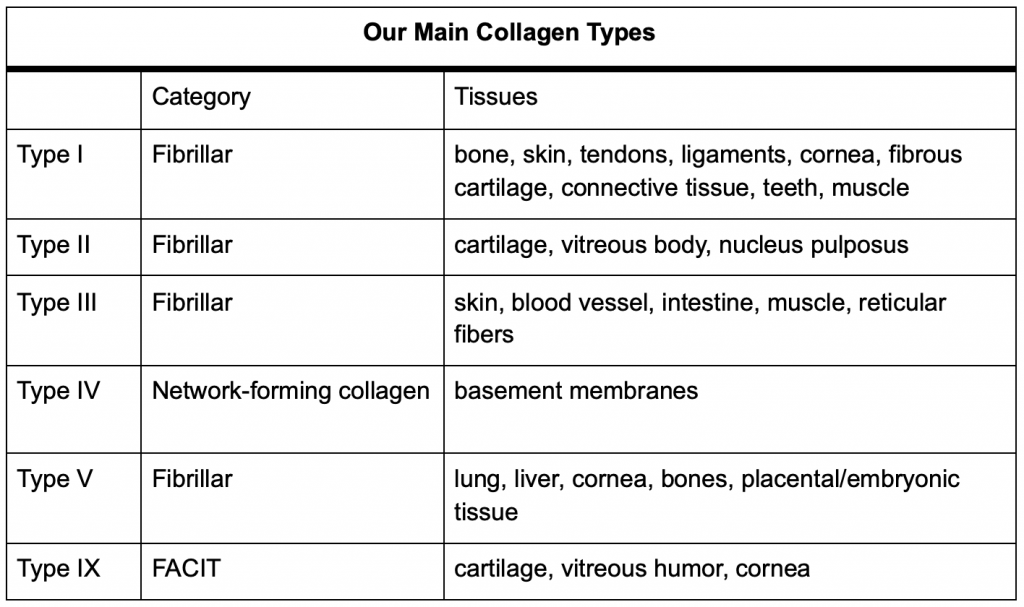
Type 2 and Other Collagens
Stacy tells Sarah how not surprised she is to hear about all this. (18:50)
She also shares how collagen’s different aspects are so interesting to her. For example, how it can support digestion.
Stacy explains how surprising it was when Sarah recommended a Type 2 supplement for back pain in a previous episode. She didn’t realize there was more than one type!
Sarah adds that Type 2 Collagen is actually vital in the makeup of cartilage.
She explains that when you consume collagen, you are actually digesting it. What ends up getting absorbed into the body is the broken-down building blocks used in other parts of the body.
Sarah also tells listeners that there’s no science behind the impacts of consuming specific collagen.
But what makes Type 2 collagen from whole food sources helpful for back and joint problems is that it’s a natural food source of a supplement for joint health.
Why It’s So Important
Sarah explains that it’s important to go through the marketing claims if different brands because the science behind it can often be outdated or untrue.
Sarah mentions that a breakdown in collagen production is known to produce a slew of different health problems.
We also know that we stop making collagen through aging, chronic inflammation, chronic stress, nutritional defiance, UV radiation, and various pollutants like smoking.
Sarah tells the audience that this breakdown doesn’t just cause sagging skin but health issues like osteoporosis, arthritis, cardiovascular disease, decreased organ function, and more.
She also explains that this is something often attributed to aging, which isn’t true.
Interruption, loss, or decrease in collagen production earlier in life can lead to these issues earlier in life.
Stacy shares it’s been helpful for her that the more she can improve her digestion, the more she can absorb other nutrients.
Some nutrients specifically support collagen synthesis in our bodies, such as Vitamin C, Copper, and Zinc.
Sarah elaborates more on what makes Vitamin C so interesting. It’s actually one of the more common vitamin deficiencies because we burn through it so quickly when we’re stressed.
Zinc is also one of the more common deficiencies. Sarah expresses how crazy that is because zinc is so important to so many different parts of the body.
Collagen, Gelatin, and Bone Broth on the Body
Stacy wonders about the validity of topical products and how effective they work, given what she and Sarah know about how collagen works. (26:54)
Collagen is essential for skin structure and function and is actually the decisive protein that determines skin physiology.
Wound Healing
Sarah explains that wound healing is a complex process that involves the immune system.
She adds that some interesting scientific data are showing that topically applied collagen can help with wound healing in several ways:
- First, exposed collagen fibers from damaged blood vessel walls help recruit platelets to the injury site to begin the clotting process.
- During the proliferative phase of wound healing, collagen is secreted by fibroblasts to form new connective tissue, providing a scaffold for the contraction of the wounded area by myofibroblasts.
- During the remodeling phase of wound healing, collagen fibers return the tissue to a more normal architecture after reorganization.
- In fact, collagen largely makes up scars
One study of long-term care residents showed that pressure ulcers healed twice as fast in the group receiving a 15-gram collagen hydrolysate supplement three times daily for 8 weeks.
Because 3 out of 4 wound healing steps use collagen, physicians use the protein to treat burn victims.
Skin Health
Sarah also tells the audience that there is a lot of research backing collagen, gelatin, and bone broth as essential for skin health.
She adds that orally taken collagen has shown a lot of success for skin health. However, the science behind topically applied collagen is not quite there yet.
The dry weight of young, healthy skin is at least 75% collagen, but this decreases as we age.
One study measured a 68% decrease in type 1 procollagen in the skin of people over 80 years old compared to people between the ages of 18 and 29!
Numerous studies have shown that collagen peptide supplementation improves skin elasticity, reducing the appearance of fine lines and wrinkles.
A 2019 systematic review of eight studies showed that collagen hydrolysate supplementation at doses of 2.5 to 10 grams per day for 8 to 24 weeks showed measurable improvements in skin elasticity and moisture.
It also showed decreases in fine lines and wrinkles.
These benefits to visible signs of skin aging are attributable to increased collagen density in the skin and reduced collagen fragmentation.
Sarah believes it’s important not to get too wrapped up in the vanity claims with collagen. She would rather focus on the improvements it can make to your body as a whole.
Joint Health
The wearing down of joint cartilage in osteoarthritis causes inflexibility, pain, and stiffness of predominantly weight-bearing joints such as the knees, hips, and spine.
Osteoarthritis is the most common form of arthritis. Autoimmune processes don’t drive osteoarthritis, like other forms of arthritis. It also accounts for about 25% of primary care physician visits among the elderly.
There’s accumulating evidence that collagen supplements can prevent and even reverse cartilage degradation in osteoarthritic patients.
A study of people with mild to moderate knee osteoarthritis showed that 10 grams of collagen hydrolysate daily over 24 weeks significantly improved a measure of cartilage quality. At the same time, those receiving placebo saw a continued deterioration of cartilage.
Collagen supplements may improve joint health in other contexts as well.
A study in athletes with activity-related joint pain showed that 10 grams daily of collagen hydrolysate for 24 weeks substantially reduced joint pain– including at rest, standing, walking, carrying objects, and lifting.
And in another study of general joint pain, patients receiving 1.2 grams daily of collagen hydrolysate were more likely to respond to treatments over 6 months.
Muscles
Loss of muscle mass as we age, called sarcopenia, is a major cause of functional decline and loss of independence in older adults.
A study of elderly sarcopenic men compared the effects on muscle mass from lifting weights three times per week with or without taking 15 grams daily of collagen peptides for 3 months.
The group taking collagen gained significantly more muscle (an average gain of 4.2kg compared to 2.9kg) and lost more fat (an average loss of 5.4kg versus 3.4kg).
A similar study performed in postmenopausal women showed the collagen peptide group gaining 1.8% fat-free mass (and loss of fat mass) compared to 0.9% in the placebo group.
Young, healthy men can benefit from collagen supplementation too.
One study in young sports students showed that those that took a 15-gram collagen peptide supplement increased muscle mass and strength more than placebo after 12-weeks of strength training.
And a study of recreationally-active young men also showed similar results, with the addition of collagen peptides increasing the effectiveness of strength training over 3 months.
A different a study looking at vitamin C-enriched gelatin, with either 5 grams or 15 grams of gelatin, as a pre-workout supplement in healthy young men, showed a dose-dependent increase in collagen synthesis in their blood an hour after exercise compared to placebo. This may help to prevent musculoskeletal injuries.
Bones
Collagen provides the scaffold for bone mineralization, so it’s no surprise that loss of collagen is associated with osteopenia and osteoporosis.
In one study of postmenopausal women taking 5 grams of collagen peptides for a year, bone mineral density of both the spine and femoral neck increased significantly compared to the placebo group.
Another study of a combined supplementation of elemental calcium, vitamin D and 5 grams of a collagen-calcium chelate for a year in osteopenic postmenopausal women, the collagen-containing supplement resulted in much less bone mineral density loss than the group receiving just calcium and vitamin D, with concurrent reduction in bloodborne markers of bone breakdown.
Two mechanisms explain the above benefits of collagen supplements:
- collagen supplies the specific amino acid building blocks for all of our body’s collagen proteins; and
- bioactive peptides produced when we digest collagen (most notably prolyl‐hydroxyproline, but some larger peptides) upregulate the synthesis of extracellular matrix proteins in various tissues (such as by increasing growth of fibroblasts and synthesis of hyaluronic acid).
Food Collagen vs. Supplement Collagen
Sarah explains that to get the benefits of collagen, there is not a difference between food sources and supplementation in terms of health.
Consuming Collagen, Gelatin, and Bone Broth
She also explains how collagen can even aid in absorbing minerals like Vitamin D and Calcium and potentially fighting cardiovascular disease.
Sarah recommends eating foods like bone broth and other organs or foods with a lot of connective tissue such as pot roast or eating off a joint.
Collagen‐rich foods include offal, skin, joints (trotters, duck feet, chicken wings, etc.), any meat that you eat off the bone, and connective-tissue-rich cuts like cheek, jowl, and chuck roasts.
She explains that many of these foods have fallen out of favor in western culture over the last few decades.
Collagen is an important supplement to take because it adds a nutrient back into our diet that we’re not getting on our own.
When we consume collagen, it’s broken down, and the individual amino acids are absorbed directly by our digestive system.
Stacy jokes that when she prepares high-collagen, she aims for that high quality “jiggle” her kids often find kind of gross.
She revisits her previous point about collagen coming from a solid source. When it gets into the not-quite-a-liquid-or-solid state, it’s starting to get back to its original form.
Sarah digresses a moment to talk about the science behind the gelatinous process and its relation to bone broth and other denatured food products.
She explains that the longer a broth simmers, the richer in collagen it ends up.
A 2019 study showed that long-simmered homemade bone broths (especially using the most collagen-rich tissues like beef marrow bones, chicken feet, or fish heads) can deliver up to 20 grams of collagen protein in one cup of broth.

Stacy invites viewers to check out a previous episode where she and Sarah discussed four day broth!
Collagen, Gelatin, and Bone Broth Digestibility
She takes a minute to clarify myths regarding how digestible raw collagen is versus denatured and other forms.
She breaks down a study performed on a group of people given different collagen supplements. The digestion of each type was measured and compared.
Stacy explains that is why people start with bone broth when they start an elimination diet.
She adds that this is due in part to the over 98% digestibility of bone broth.
Stacy compares this to vegan diets and explains that fruits and vegetables’ digestibility, especially raw, is a lot lower.
Sarah breaks down the different degrees our bodies absorb plant and animal proteins from most to least digestible: fish protein, land animal, followed distantly by plant proteins.
She also explains that these levels vary greatly from one to the next and explains a little bit about how and why that works.
Sarah also breaks down how scientists measure how much the body absorbs of each type. She attributes these differences to varying incompatibility of each structure.
Non-Food Sources of Collagen
Stacy suggests they dive into some non-food sources of collagen. (49:49)
Sarah agrees, expressing the creation of supplemental collagen is the place to start.
She recaps how boiling a collagen-rich food denatures the collagen, breaks apart the molecules apart, and then dissolves them into water. This then turns into gelatin.
Sarah also explains that gelatin was actually a form of glue in ancient Rome. And up until the late 1800s, gelatins were made as fancy dishes and were basically a form of super-rich broth.
However, the product’s process in the factory would not allow for the “USDA Organic” label.
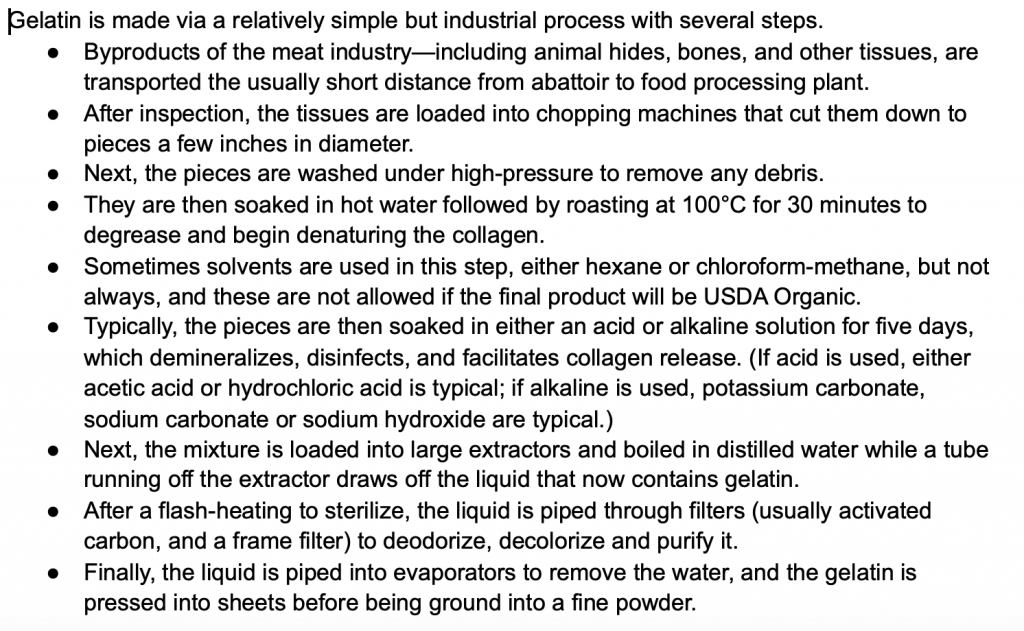
Sarah explains that this process is optimized to extract the most gelatin possible. And in this optimization, there has been (in some cases) the introduction of some harsher chemicals in the process.
She also says how surprising it is that it’s not possible to find organic gelatin, even though we do have organic meat and enough organic raw materials to make organic gelatin.
However, the process that the product has to go through in the factory would not allow for the “USDA Organic” label.
Legitimacy of Market Claims
Stacy agrees that she also find that all very interesting. Primarily how there are so many different processes in making it. (55:20)
When she first discovered a branch she was using had introduced changes in its ingredients, it started a whole mindset for backing up a little bit and looking deeper into non-disclosed ingredients.
For example, she uses similar industrial acids to make bone broth from different kinds of vinegar and citrus juices.
Stacy also tells listeners she and Sarah will talk about ingredients found on labels. But manufacturers don’t disclose the ingredients Sarah described on a label.
This is because it’s involved in the “bones” of the product. This is just the base to get to the gelatin, and they aren’t at the collagen peptide stage yet.
Stacy explains that they’ve only covered the process for gelatin, which is something that solidifies as it cools. Getting something like this to dissolve into something else requires the solvent to be hot.
If you’re looking for something to add to a cold beverage, it takes even more steps to get to a collagen peptide.
Brand Transparency
Stacy reiterates a takeaway so far is the idea that not all are created equal.
That is why she and Sarah asked Paleovalley to sponsor this show because it’s a brand that Sarah has vetted and looked into quite extensively.
She also jokes she’s a little heartbroken that they don’t carry a collagen peptide. But she assures listeners Sarah will explain a little bit more on why about that later on in the show.
Stacy also reiterates for listeners that the ingredients you may want to be avoiding most, like harsher chemicals, are not going to be listed on the tables as an ingredient.
Stacy explains that she personally went out to a brand to ask these types of questions because there’s absolutely no way of knowing otherwise.
She also expresses how unfortunate it is that that’s how the system works regarding what manufacturers disclose and not disclose.
But that’s why she and Sarah want listeners to understand the process and understand what to look for, ask about, and all that kind of stuff.
Sarah shares she’s done similar things with brands, even to the point of having to sign an NDA (Non-Disclosure Agreement) to get the answers to her questions.
Sarah hopes to alert listeners that some products marketed to our community take advantage of our health-consciousness and goals to sell us products without the transparency we deserve.
Collagen Peptides
Moving into the topic of collagen peptides, Sarah reiterates Sarah’s point that gelatin becomes a solid as it cools.
The benefit of collagen peptides as a supplement, compared to gelatin or bone broth protein, is that it dissolves in cold water.
It does that because it goes through an additional step, where the gelatin is mixed with enzymes that “predigest” the collagen.
The most common enemies used are papain, alcalase, α-chymotrypsin, pepsin, trypsin, collagenase, and bromelain. And they are all enzymes commonly found in our bodies.
Sometimes enzymes are added concurrently with acid treatment. The most common combination is acetic acid and pepsin. The length of this process depends on the proprietary enzyme mix used.
Sarah mentions that it can be very difficult to get information on what specific brands use during this process.
After enzymatic hydrolysis, the same filtering, concentrating, drying, and grinding as with gelatin takes place.
Sarah thinks it’s helpful to understand that there is a wide range of different processes. They are not all-concerning.
This 2019 review paper has a very good summary of the various manufacturing processes used to make collagen peptides.
She also explains that the only advantage of collagen peptides than a food source is the ability to stir it into cold water.
The tradeoff is an opaquing process in manufacturing not listed on the label.
All the research Sarah has done into these processes has been enough to convince her to switch gears.
Stacy explains it’s super difficult to look at this information and know how much she’s come to love collagen in her coffee.
After researching and changing brands, she still feels good. So for her, there are more things to consider, including other additives.
Marine vs Bovine Collagen
Stacy explains that “Marine Collagen” is just another way to say collagen taken from fish. (1:03:46)
Sarah explains that you can use different source materials to make collagen supplements. The big difference is the little bit of a shift you’ll see in amino acids.
Marine collagen typically uses fish scales. Marketers claim it has more glycine, but it depends on the exact source and varies from brand to brand.
- One major brand’s marine collagen is 24.1% glycine, whereas their bovine hide collagen is 20.7%.
- Another major brand’s marine collagen is 22.7% glycine, whereas their bovine hide collagen is 23.3%.
Sarah reminds listeners that there is no “rule” that marine collagen is way better. It is mostly up to your specific needs.
Sarah also cautions listeners that having an allergy to the source material can still cause a reaction to the supplement.
One reason to choose marine collagen is an allergy to beef or pork, but not to fish. And this is true the other way around as well.
Marine and bovine collagen are similar in terms of sustainability.
The Truth About Multi-Collagen Supplements
Multi-collagen supplements typically include several hydrolyzed collagens from various sources. This includes bovine or porcine hide, egg membrane collagen, hydrolyzed fish collagen, and bone broth protein.
Sarah explains that you’re paying for all these fancy ingredients with these multi-collagen supplements that your body digests around 99% the same.
Scientific studies have not identified any special bioactive peptides in more expensive collagen hydrolysate ingredients found in multi-collagen supplements to justify the increased expense.
Because the body so readily digests collagen, your body mostly absorbs the constituent amino acids.
She adds that no science shows collagen from one source acts any different from collagen from another source when you consume it, with few exceptions when it comes to types.
Some whole food sources of collagen can contain added benefits. For example, type 2 collagen can also be rich in glucosamine chondroitin, a nutrient well-established to support joint health.
Sarah makes it a point to be clear that the benefit of these supplements is the additional molecules in those tissues and not the different types of collagen itself.
Importantly, there is no one-to-one correspondence between the type of collagen consumed and the type of collagen your body makes.
Bone Broth Protein
This protein comes from dehydrated bone broth.
Sarah cautions listeners to look if a label says that a bone broth protein has been hydrolyzed. This is just a sneaky way to say it went through that enzyme hydrolysis step.
Basically, they make bone broth and then do the industrial enzymes step to dissolve in cold water.
However, if the label says simply bone broth protein or bone broth collagen, you have the least processed option for a collagen supplement! Congratulations!
Digestibility Myths
Brands often market collagen hydrolysate and collagen peptides as easier to digest and absorb than gelatin or bone broth protein.
While this makes sense on the surface (they’re predigested with enzymes after all), this is a myth.
When proteins have high compatibility with our digestive processes, they tend to be close to completely broken down. They are absorbed before reaching the large intestine.
Digestibility is measured by looking at the difference between the number of amino acids in the ingested protein versus the amount of amino acids recoverable from the “other” end.
Raw Collagen
It’s true that native (raw) collagen is insoluble and, therefore, not quite digestible by our pancreatic enzymes as some other protein sources.
- One rat study from the 1980s compared the digestibility (with or without suppressing stomach acid) of native collagen and gelatin compared to meat, with whole egg as the 100% digestible standard.
- After stomach acid suppression, native collagen was only 71% digestible; but with stomach acid added, its digestibility increased to 95%.
- On the other hand, gelatin was equally digestible with or without stomach acid, and its calculated true digestibility was 98.8%.
- For reference, the digestibility of meat in this study was 97.1%.
- Other studies (like this one) show similar results: unless we’re gnawing on raw chicken wings and taking huge doses of antacids, collagen and gelatin are highly digestible proteins.
- That means that collagen peptides do not possess a digestibility advantage over gelatin or bone broth protein.
Gelatin vs. Peptides
Sarah also states that there doesn’t seem to be a big difference in how gelatin versus collagen peptides stimulate collagen synthesis once consumed.
- In one study, healthy young men received a placebo, a supplement containing 15 grams of gelatin, a supplement containing 15 grams of hydrolyzed collagen, or a supplement containing 7.5 grams each of gelatin and hydrolyzed collagen.
- An hour after consuming the collagen, participants jumped rope for 6 minutes to stimulate endogenous collagen synthesis.
- Four hours later, researchers drew blood and looked for markers of collagen synthesis to measure.
- The study revealed no significant difference between the collagen-derived amino acids circulating in the blood between the three different collagen supplements.
- Although all showed results substantially higher than placebo.
- And, circulating procollagen was 20% higher after gelatin or hydrolyzed collagen compared to placebo.
- So, from a supporting-collagen-synthesis-in-our-bodies perspective, gelatin and hydrolyzed collagen perform equally well.
Question Listeners Should Ask
Stacy takes a second to go back and add that another reason someone might choose bovine vs. marine collagen is anyone trying to stay kosher. (1:12:06)
She also adds he the bone broth protein available through Paleovalley is beef and not pork.
Sarah encourages anyone wondering where the collagen they use comes from to email the brand and ask.
She expresses how underwhelmed she’s been with FAQ lately. She also says these are not the type of questions you’ll find just by poking around.
- Are there solvents, or other chemicals, used to wash the hides (or other source materials)? If so, which ones?
- Are the hides treated with acid or alkaline during any step, and if so, which ones?
- What agent neutralizes the product if treated with acid or alkaline?
- Are there carrier molecules or manufacturing aids used in the drying process, and if so, which ones?
- Is the finished product third-party tested for contaminants?
Sarah talks a little bit about third-party testing. And that’s the type of transparency companies show. That they are ensuring every batch is at the same level of quality they are known for.
One recent ConsumerLab.com test of 14 popular collagen supplements contained high levels of the heavy metal cadmium.
Stacy shares that with the brand that she reached out to, the company owner went back to validate with his manufacturer.
She adds that companies often source their ingredients from elsewhere or off-label, and the answers to these questions aren’t on any FAQ list.
Reading Labels & Icky Ingredients
Stacy encourages listeners always to read their labels. Even if you find one you like, and you buy it regularly, you need to check the label.
Both Stacy and Sarah have been surprised at brands changing their ingredients as of late.
Often brands won’t even change their labels, so it can be very difficult to realize something is different until you start to feel crappy.
Stacy also explains that many brands market things as “protein powders,” which means It’s not pure collagen protein but many other additives.
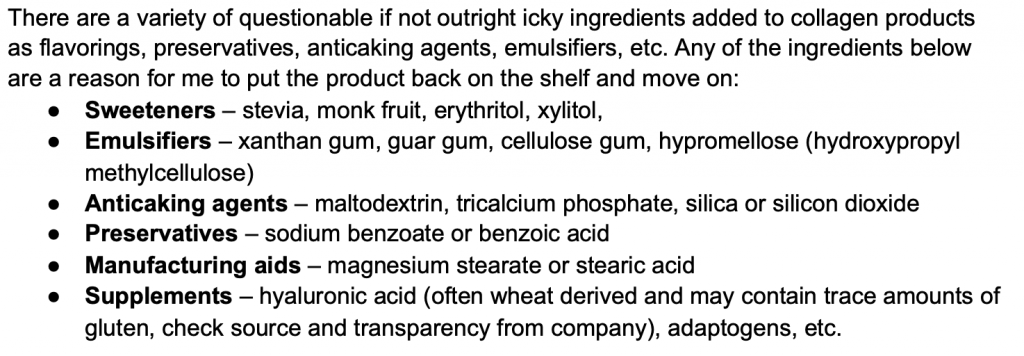
Stacy knows this can be exhausting and frustrating. That’s why she and Sarah spent months researching for this show and talking to brands.
It’s also why they feel confident in partnering with Paleovalley on this topic because they know their intent and their brand decisions in the event they make a change.
Don’t Be Afraid To Ask
Stacy encourages listeners when looking at brands to ask if they are committed to a certain type of decision for a reason, or would they be likely to change to save a little money?
She knows that the larger a brand gets, the more they have to find ways to cut costs. It’s a capitalist market, and she’s not shining any hate on that.
Stacy feels that as a consumer if you’re putting something in your coffee every morning for your health, she doesn’t want additives she doesn’t want in her body.
Sarah revisits a list of common ingredients she and Stacy have cautioned listeners against in the past.
Stacy reminds listeners, and she is all about keeping it simple and helping your body just be the best that it can be.
She adds the last thing she wants to do is sell you on needing 47 different things to be well.
You can add just add collagen, bone broth protein, and gelatin to things in your home if what you want is just a workout beverage. You can do that yourself.
Where Stacy Has Landed With This
Stacy cannot let go of Collagen Peptides in her coffee. She says maybe it’s something she’ll try weaning herself off of, but for now, it’s staying.
She has changed brands and but still uses Paleovalley elsewhere, like smoothies.
Stacy asked the questions mentioned earlier to a brand that listed clean ingredients for their peptide proteins that didn’t have all the additives listed in many brands.
If you’re interested in checking them out, visit this equipfoods.com link. Using “STACY” at checkout gets you 15% off!
Even though she isn’t switching, Stacy does recommend listeners try Paleovalley’s bone broth protein in their foods to see if they like it. She just can’t envision her coffee without Collagen Peptides.
Sarah tries to make a pitch to Stacy. She says that the Paleovalley bone broth protein has very little flavor and was skeptical.
She was super surprised she couldn’t taste it in her coffee at all. Sarah also says that because it’s not as broken down as peptides, it does foam a little more.
With winter coming, she’s getting back into the habit of a mug of homemade broth as well. She encourages listeners to put bone broth protein in a mug of broth.
Where Sarah Has Landed With This
Sarah completely switched to Paleovalley 100% Grass-fed Bone Broth Protein.
This is because it comes from slow-simmering 100% grass-fed beef bones in filtered water, just like she would at home.
Then it’s gently powdered with no additives and never treated with chemicals or high-heat, and it’s third-party tested for contaminants.
Sarah also states that she has not seen a higher-quality source of collagen on the market.
She adds Paleovalley Bone Broth Protein to her morning coffee.
Sarah does tell viewers it’s better stirred in rather than blended since it tends to foam a lot if blended. She also adds it to soups, stews, stir-fries, and even baking.
It has very little flavor, so she says she can’t taste it at all in my coffee. You can turn it into a warm cup of broth by mixing it into hot water and adding salt to taste.
There’s also a huge advantage of consuming bone broth protein rather than homemade bone broth: concentration and consistency.
Incidentally, the most concentrated broths in the study were those made with beef marrow bones simmered for 72 hours. The addition of vinegar has a negligible effect on amino acid extraction.
These broths delivered close to parity amounts of collagen protein in a one-cup serving. Good news for our favorite traditional healing food!
On the other hand, bone broth protein is standardized and concentrated, so you know you’re getting the right dose every time!
She still uses homemade bone broth for soups, stews, and other recipes that call for broth. But She chooses Paleovalley Bone Broth Protein for her daily collagen supplement.
How Much Collagen to Take
Stacy shares that she isn’t really one for paying attention to how much collagen she consumes. So she asks Sarah, “How much is too much and does it count?” (1:37:27)
Sarah tells her that, yes, it does count.
Most studies showing benefit of collagen supplementation, whether gelatin or collagen hydrolysate, used doses between 10 and 20 grams daily.
However, you can consume quite a lot more than that without jeopardizing your diet’s amino acid balance as a whole.
Collagen is an incomplete protein that is completely lacking in the essential amino acid tryptophan, so it has a PDCAAS of zero even though it’s highly (98.8%) digestible.
Researchers have used iterative PDCAAS calculations to show that collagen peptides can make up to 36% of our dietary protein. This is while still ensuring they meet indispensable amino acid requirements.
That means that if you’re aiming for 150 grams of protein daily, you can safely get a little over 50 grams of that from collagen! For reference, that’s three heaping scoops of Paleovalley 100% Grass-Fed Bone Broth Protein.
Final Thoughts
Stacy also adds that paleovalley beef sticks are LEGIT! Her kids ate them immediately and then asked when she was ordering more. She highly recommends listeners grab them if they can!
Sarah adds that their turkey sticks are AIP too! And so good! And they have encapsulated organ meat that includes liver, heart, and kidney!
To sum up, Sarah and Stacy really recommend checking out Paleovalley and all their amazing products. You can follow this link to the website to automatically get the 15% off deal or use the coupon code “thewholeview15” at checkout.
Both Stacy and Sarah share that they share information with you very seriously and are nothing but open and honest.
Stacy reminds listeners that they are even more open and honest over on their Patreon channel, where you can hear even more of their unfiltered thoughts.
Big thanks to Paleovalley for sponsoring this amazing show. Thank you so much for listening, and we will see you next time!
